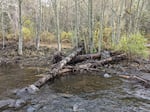The Rogue River Watershed Council has been restoring sections of Little Butte Creek north of Medford. It’s part of a unique partnership focused on cleaning up drinking water and restoring fish habitat that has provided almost $4 million dollars for environmental projects across the Pacific Northwest.
The program, from the Drinking Water Providers Partnership, provides grants across Oregon and Washington that simultaneously improve drinking water quality and restore fish habitat.
The partnership is taking new applications for projects through Jan. 7, 2023.

Biologist Lance Wyss points at the riparian forest they've restored near the creek. The entire area behind him was filled with invasive blackberry bushes.
Roman Battaglia / JPR
“One of the real benefits, I think, of this kind of partnership is to recognize the connection between clean, safe drinking water, public health, and restoration projects that benefit all the other beneficial uses,” says Craig Harper, watershed administrator for the Medford Water Commission, which provides drinking water to residents of the Rogue Valley.
Harper says Little Butte Creek empties out directly where the commission collects water from the Rogue River.
The Rogue River Watershed Council has been removing invasive species and placing logs in the creek to slow erosion and filter out contaminants.
Restoration Biologist Lance Wyss points out a new livestock fence they installed to restore riparian forest along the creek.
“It creates a larger filter from the stream and what the groundwater has to go through,” Wyss says.
Once the cows were moved further away from the creek, Wyss and his team were able to focus on invasive blackberry bushes that had taken over the riparian forest, outcompeting native shrubs and grasses.
“We’re just getting something out of the way for the natural process to start again,” he says. “So we’re helping the riparian forest recover by getting the major impediment out, which is usually Armenian blackberry” (also known as Himalayan blackberry).

The South fork of Little Butte Creek, where the Rogue River Watershed Council has been doing restoration work. They placed logs throughout the creek to slow the river down and reduce erosion, as well as provide habitat for native fish.
Roman Battaglia / JPR
Wyss says they haven’t done any seeding on this project at all. Once the invasive species are removed, the native plants that were once struggling are able to thrive again.
By cleaning up the feeder creeks like Little Butte, the water that comes into the treatment plant is cleaner, and requires less filtering or chemical treatments to make it safe to drink.
Their work will improve water quality for hundreds of thousands of residents who use water along the Rogue River.
This is one of four projects that the Rogue River Watershed Council has been funded through the DWPP. A restoration of a portion of Bear Creek in partnership with the City of Rogue River is their next proposal, according to watershed council Executive Director Brian Barr.
This partnership breaks the mold of siloed government programs and brings together groups that may not typically communicate, according to Tonya Graham, executive director of the Geos Institute.
“Over time, as they get to know each other, as they develop that partnership, they may find other places where they can work together that are not necessarily Drinking Water Provider Partnership type projects, but they’re something else that benefits the community and the landscape at the same time,” Graham says.
The Geos Institute helped found the DWPP in 2016 to combine separate funding sources.
Applicants apply for the partnership as a whole, and the institute, working with both state and federal agencies, decide where each proposal should receive funding from.
Graham says each of the five funding sources has different requirements, so this process makes it easier for applicants by taking out some of the research and time needed to fill out multiple applications.